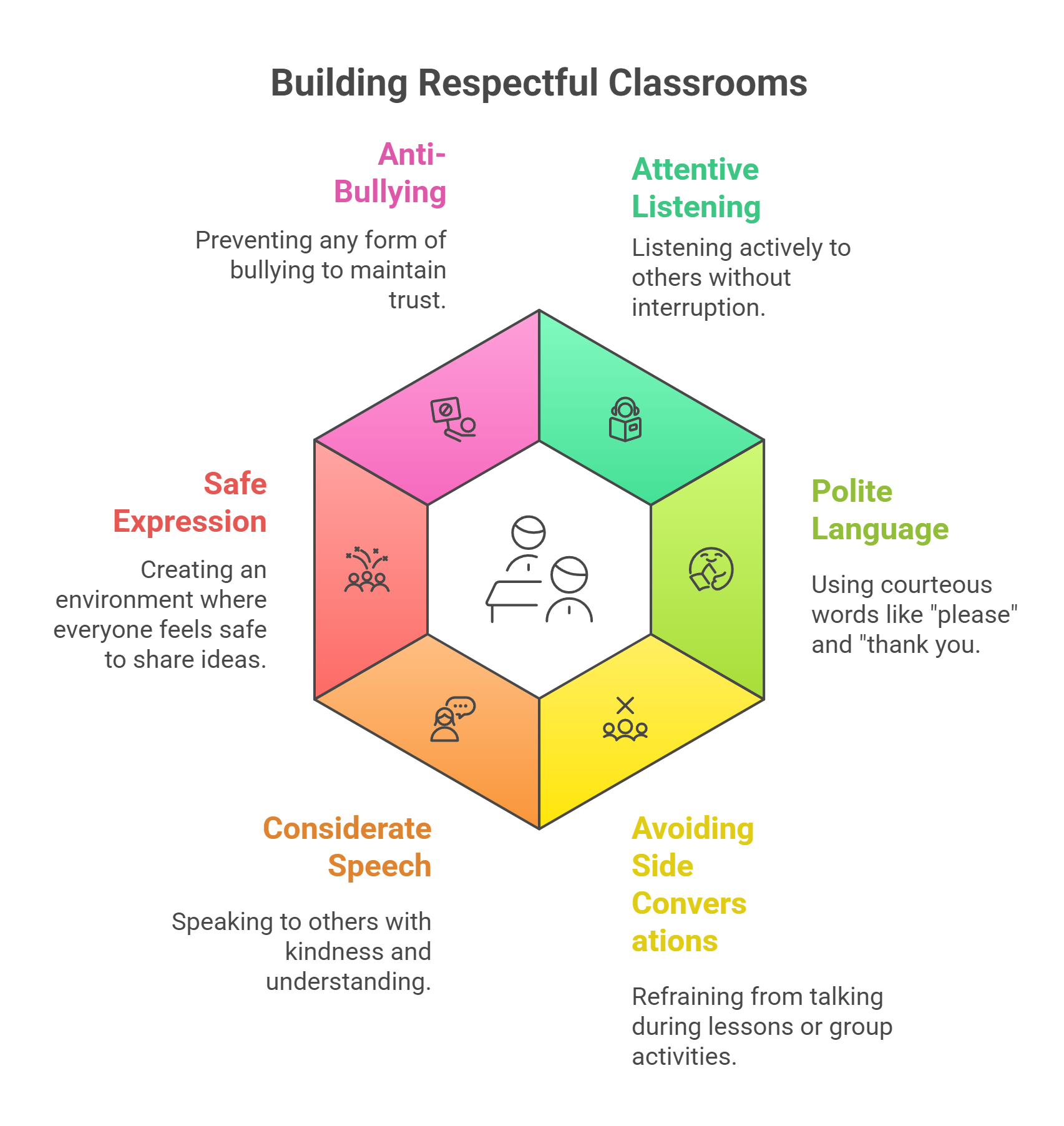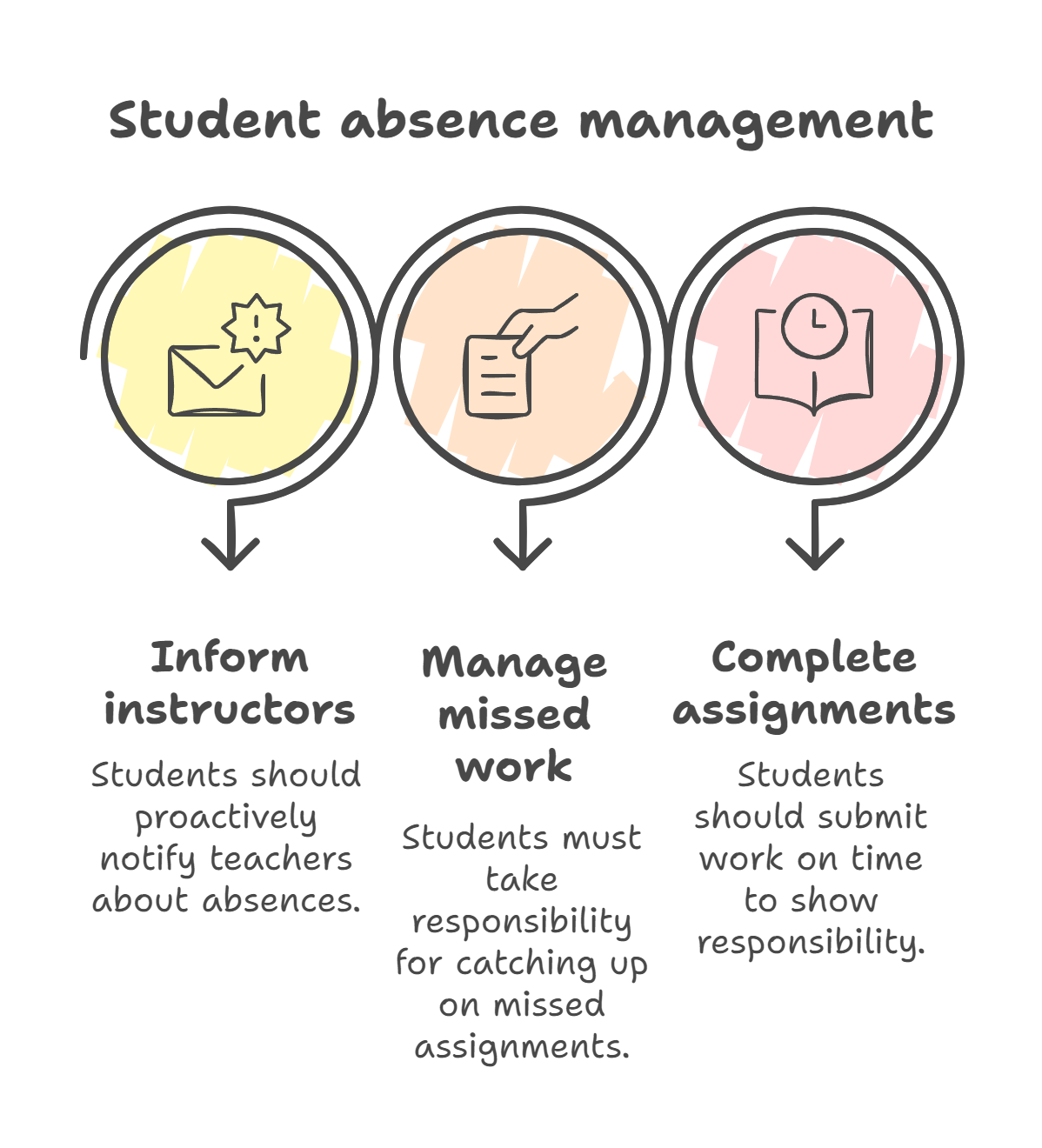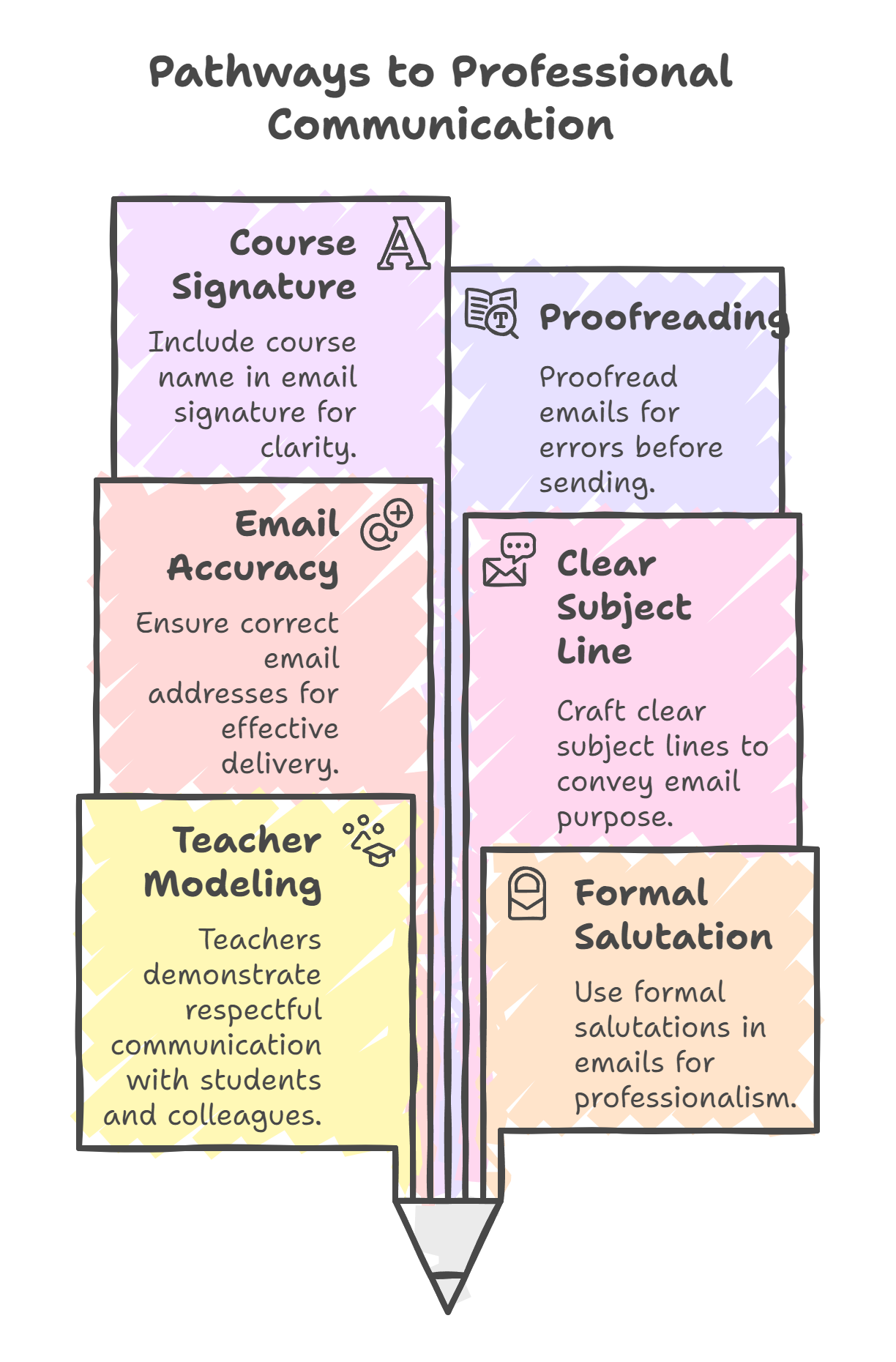Have you ever noticed how the atmosphere in a classroom can make or break your learning experience?
This means that setting the right ground rules from day one is beyond keeping order. The right atmosphere shapes the way students connect with teachers and each other. In fact, many experienced educators agree that a respectful and focused environment lays the groundwork for real academic achievement.
In this article, you’ll find practical tips for upholding classroom etiquette, with each point explicitly explaining how it contributes to students’ success.
Everyone, including a student eager to do their best or a teacher aiming to build a positive classroom culture, can take these etiquette essentials as a headstart towards success.
Let’s dive in.
Principales conclusiones
- Core principles of classroom etiquette include respect, responsibility, and minimizing distractions to encourage a productive learning environment.
- Active participation, punctuality, and respectful communication are essential for maintaining proper classroom behavior and increasing mutual respect among students and teachers.
- Good etiquette helps students learn more effectively by stimulating responsibility and mutual respect, promoting positive relationships, and preparing them for future academic and professional success. It also emphasizes the importance of honesty and professionalism in communication.
Core Principles of Classroom Etiquette
There’s more to a good classroom etiquette than just following rules. Instead, it’s more about creating an atmosphere where everyone can learn comfortably and confidently. Fundamentally, etiquette comes down to three main values: respect, responsibility, and keeping distractions to a minimum.
Sometimes, classroom rules can feel a bit strict or one-size-fits-all, especially in varied classrooms where backgrounds and expectations may differ. However, many seasoned teachers have observed that these guidelines actually give students the space to express themselves and collaborate more effectively.
So what does this look like in action?
Respect for Teachers and Classmates

Respect starts with how we treat each other. In practice, this means:
- Listening attentively when someone’s speaking.
- Using polite language, that is, saying “please” and “thank you” when borrowing supplies or asking for help.
- Avoiding side conversations during lessons or group activities.
- Speaking to classmates and teachers in a considerate way, even when you disagree.
- Creating space for everyone to express their thoughts safely.
Not to mention that bullying, whether casual teasing or something more serious, undermines this sense of trust and shouldn’t find a place in any classroom.
Responsibility and Preparedness
Responsibility is seen much more in everyday habits. Students who come prepared, whether through completing readings, arriving on time, and bringing materials like notebooks or laptops, demonstrate respect for their own learning and their peers’ time.
Starting class a few minutes early, for example, allows everyone to settle in and kick off discussions smoothly, regardless of whether you’re in a traditional classroom or a virtual learning setup.
Minimizing Distractions
Distractions can crop up anywhere, but a few simple habits help keep everyone on task. Silencing or stowing away phones, keeping your workspace tidy, and waiting until breaks to chat with friends all contribute to a more productive atmosphere.
A teacher can adopt this method by allowing students to use chat functions only as needed during lessons, helping everyone stay on the same page.
Essential Rules for Students
Following essential rules is another factor to maintaining proper etiquette in the classroom. Clear and specific rules provide students with defined boundaries, facilitating a productive learning atmosphere.
Reinforcing these rules throughout the school year helps reduce excuses for misbehavior and promotes obedience, good manners, discipline, and respect.
Cooperation with classmates and respecting their rights are also significant aspects of classroom etiquette for the entire class, as well as for other students. Showing patience and respect when interacting with a classmate, such as when borrowing items, is equally an important part of classroom etiquette.
Arriving On Time and Staying Until the End
Punctuality is essential for classroom preparedness because:
- It prevents interruptions, ensuring a smooth learning environment.
- It shows consideration for both the instructor and classmates.
- It indicates mutual respect.
Punctuality and staying until the end maximize learning opportunities and reinforce classroom etiquette during class time.
Participating Actively and Politely
Active, polite participation is vital for a healthy classroom environment. Speaking politely and clearly during classroom discussions is important. For example, students should wait their turn to speak and use respectful language.
Teachers can even go the extra mile by creating guidelines for respectful dialogue, which encourage talking participation without fear of judgment.
Managing Absences and Make-Up Work

Responsibly managing absences is another facilitator of classroom etiquette. Students should:
- Inform instructors of absences in advance.
- Arrange to manage missed work.
- Complete assignments timely to demonstrate responsibility and help avoid cheating.
For educators, informing parents about absences and teaming up with them can help manage missed work and support student success.
Academic Integrity: Upholding Honesty in the Classroom
Academic integrity is a cornerstone of the learning process and also an integral part of classroom etiquette. Students must be aware of school rules and guidelines regarding honesty in their academic work.
Upholding these rules not only demonstrates respect for classmates and the instructor but also preserves the value of everyone’s educational achievements. Producing original work and giving proper credit for sources are essential behaviors that support a fair and honest classroom environment.
Violations such as plagiarism or cheating can lead to disciplinary action, which may have serious consequences for a student’s academic record.
Group Work and Collaboration: Succeeding Together
When participating in group projects, it’s important for students to respect their classmates and the instructor by contributing fairly and listening to different perspectives. Successful collaboration means being aware of school rules and guidelines for group work, ensuring that everyone has a chance to participate and learn.
This sense of collaboration helps students learn from each other’s strengths and experiences, making the learning process more rewarding. Following the rules and maintaining open, respectful communication within the group helps prevent misunderstandings and ensures that the final project reflects the efforts of the entire class.
Time Management and Organization for Academic Success
Mastering time management and staying organized can transform a stressful school year into a smooth and successful one. Knowing your school’s deadlines, assignment expectations, and class schedules is just the start. The real game-changer comes from building habits that help you track and tackle your workload effectively.
Many students today turn to digital tools that blend convenience with productivity. Apps like Google Calendar and Microsoft To Do allow you to set reminders for deadlines and plan study sessions, so nothing slips through the cracks.
For breaking down bigger projects, a tool like Trello provides visual boards where you can map out each step, making large tasks feel more manageable.
Keeping a digital or physical planner remains a reliable strategy. Writing down assignments, tests, and important dates helps reinforce what’s coming up. Combine this with setting aside dedicated time blocks daily or weekly for studying, reviewing notes, or finishing homework. These habits help you prioritize tasks rather than feeling overwhelmed by everything at once.
Taking this one step further, “chunking” tasks, which means dividing big assignments into smaller, focused pieces, makes starting and completing work less daunting. For example, instead of “write research paper,” break it down into “research topic,” “create outline,” “write introduction,” and so on.
Students who do these are better prepared academically, plus, they develop essential life skills that serve them well into college and the workplace.
Teacher Etiquette: Setting the Tone
Teachers are the architects of the classroom atmosphere. From day one, their actions and expectations guide students toward a respectful and productive learning environment. Just as coaches lead their teams, teachers lead their classrooms, establishing the order necessary for effective instruction.
Establishing Clear Behavior Standards
A classroom often rides on clear expectations. Instead of simply dictating rules, many teachers find success by involving students in creating them.
For instance, a teacher might facilitate a class discussion at the beginning of the year: “What kind of classroom helps us all learn best?” and collaboratively list agreed-upon behaviors. To reinforce this, a “Classroom Etiquette Checklist” or a visual “Our Classroom Agreement” poster, co-signed by students, can serve as a tangible daily reminder.
Regularly discussing these agreed-upon standards ensures they remain relevant and consistent with broader school guidelines, addressing any inconsistencies proactively.
Modeling Respectful Communication

Teachers consistently model respectful communication, whether interacting with students or colleagues. This demonstrates the value of positive peer interaction and collaboration. For students, seeing teachers communicate respectfully with one another reinforces the importance of using polite language and clear, thoughtful expressions.
When communicating via email, a professional approach is key:
- Always use a formal salutation like “Dear Mr./Ms. [Name].”
- Ensure the recipient’s email address is correctly entered.
- Craft a clear subject line that immediately conveys the email’s purpose.
- Include your course name in your email signature for clarity.
- Always proofread for spelling, grammar, and punctuation before sending.
- Keep your messages clear, concise, and well-structured.
Encouraging Inclusive Participation
A truly dynamic classroom is one where every voice feels valued. Teachers play a critical role in drawing out all students, especially those who might be quieter.
One effective strategy is using structured participation methods like “Think-Pair-Share,” where students first reflect individually, then discuss with a partner, and finally share with the larger group. This gives all students time to formulate their thoughts before speaking publicly.
Another approach is to rotate responsibility for leading small group discussions, or using online polling tools for anonymous contributions.
Impact of Good Etiquette on Learning Environments
Good etiquette facilitates smooth interactions among students and teachers, significantly impacting the learning environment. It cultivates a positive learning atmosphere and increases student engagement.
Providing clear and well-cited answers to questions is an important aspect of classroom etiquette that supports effective learning. A structured classroom environment maximizes instructional time and enhances student learning.
Enhancing Focus and Minimized Disruptions
Proper classroom etiquette reduces distractions, improving student focus and learning. Organization helps students focus and relax, enhancing learning outcomes. A tidy classroom plays a huge role by minimizing distractions and helping student focus.
Students should ensure their virtual background is appropriate and non-distracting during online sessions.
Building Mutual Respect and Positive Relationships
School etiquette further promotes self-respect among students. Proper etiquette enhances respect for peers and teachers, fostering positive relationships. Plus, school etiquette creates a respectful and supportive classroom environment.
Etiquette-nurtured mutual respect makes individuals aware and contributes to a collaborative learning atmosphere, creating a sense of community.
Preparing Students for Future Success
Every student is entitled to learn without being deprived by others. Good etiquette cultivates professional habits valued in higher education and the university workplace. This preparation is important for success in college and professional lives.
Virtual Classroom Etiquette
Even virtual classrooms are not left out as they have become a core part of education, but they bring their own set of expectations to keep learning smooth and respectful.
Students can help by using features like the “Raise Hand” button to wait their turn during discussions, following teacher guidelines carefully, and showing patience when tech glitches happen. Recording sessions without permission is off-limits to protect everyone’s privacy.
Technical Preparedness
Before class begins, taking a few minutes to check your internet connection, camera, microphone, and headphones can prevent interruptions.
Headphones because they not only boost your audio quality but also help block background noise, making it easier for you and your classmates to focus.
Having a backup device or a hotspot ready can also be a lifesaver if your primary connection fails.
Maintaining Professionalism Online
Staying professional while attending classes remotely means:
- Sitting at a desk or table rather than lying down.
- Keeping good posture and minimizing unnecessary movement.
- Using headphones to reduce noise distractions.
- Letting your teacher know if you need to step away or turn off your camera.
These simple habits help create a respectful environment that mirrors an in-person classroom’s focus and decorum.
Managing Digital Distractions
Distractions lurk everywhere online, but some quick fixes make a big difference:
- Choose a quiet, well-lit space free from interruptions.
- Silence notifications on your phone and computer before class starts.
- Avoid multitasking like browsing social media or doing unrelated work.
- Use the chat feature thoughtfully to ask questions or seek clarification without interrupting the speaker.
Cell Phone Etiquette in the Classroom
Cell phone etiquette is a key aspect of respectful classroom behavior. Students should be aware of school rules and guidelines regarding cell phone use during class time. Using a cell phone responsibly means silencing it or keeping it out of sight to avoid disrupting the learning process for themselves and other students.
Respecting these rules shows consideration for classmates and the instructor, helping to maintain a focused and productive classroom environment.
By minimizing distractions caused by phones, students can fully engage in the lesson and contribute positively to the entire class.
Email Etiquette for Students
Clear and professional email communication is a vital skill for students. Being honest and straightforward in your emails helps build trust with teachers and shows integrity. Avoiding deception in any form keeps the lines of communication open and respectful.
Using Professional Language
Emails that use polite and formal language show your seriousness and respect for the recipient. Skip slang, emojis, or shorthand, and instead focus on clear, mistake-free writing.
Taking the time to proofread your email for spelling, grammar, and punctuation helps you make a strong impression. When you have several questions, listing them separately with numbers helps your teacher respond clearly and efficiently.
Structuring Emails Correctly
A well-structured email makes it easier for your teacher to understand and respond. Always include your full name and class or course number early in the message to identify yourself quickly. Use a straightforward subject line that summarizes the reason for your email, such as “Question Regarding History Assignment Due July 30.”
Before hitting send, double-check that any necessary attachments are included, as missing files can slow down the reply and cause confusion.
Following Up Respectfully
If you need to follow up, always do so politely. Thank the teacher for their time and help, which shows that you appreciate their effort and encourages positive communication going forward.
Below is a sample email for your guide:
Request for Extension on History Assignment Due July 30
Dear Mr. Thompson,
My name is Sarah Johnson, and I am in your History 101 class (Section B). I am writing to request an extension on the assignment due July 30, as I have been dealing with some unexpected personal challenges this week.
Would it be possible to extend the deadline by three days?
Are there any additional guidelines I should follow when submitting late work?
Thank you very much for your understanding and support. I appreciate your time and look forward to your response.
Sincerely,
Sarah Johnson
History 101, Section B
Resumen
Classroom etiquette is the foundation of a respectful, productive learning environment. These habits put together build skills for academic and professional success.
Therefore, embrace etiquette as a tool to unlock your potential, and you’ll be on your way to building a foundation for a bright future.
Preguntas frecuentes
What is classroom etiquette?
Classroom etiquette involves adhering to behaviors that encourage respect and a positive environment, such as listening attentively, participating politely, and respecting diverse opinions.
Why is classroom etiquette important?
Classroom etiquette is important as it stimulates respectful communication, minimizes disruptions, and improves academic performance, ultimately creating a conducive learning environment.
What should a student do if they have to miss a class?
Notify your professor before the absence if possible, and take responsibility for catching up on any missed work. This demonstrates professionalism and respect for the course.
How should students handle disagreements in class?
Students should focus on ideas rather than personal disagreements and maintain respect for their classmates’ viewpoints. This approach cultivates a constructive and collaborative classroom environment.
What are some challenges in maintaining classroom etiquette?
Maintaining classroom etiquette can be challenging due to peer pressure, lack of motivation, and the distractions posed by digital devices. Addressing these issues is essential for a respectful learning environment.

